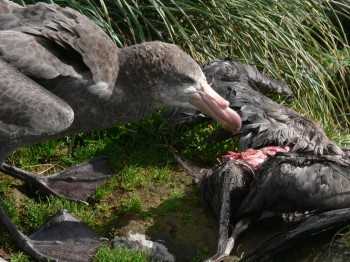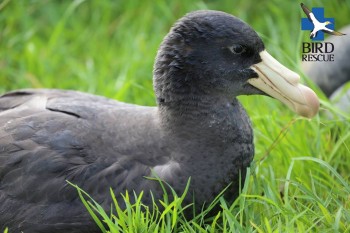On islands all around the Southern Ocean ornithological field researchers are starting the busy season as most of the seabird species return to breed.
Australia’s latest This week at Macquarie Island on-line newsletter reports from the southern Pacific:
“Our TASPAWS rangers, ranger in charge Chris and wildlife ranger Mike, are this week conducting a wildlife census of nesting northern giant petrels. These giant petrels are present in considerable numbers on Macca, but like albatrosses, they are endangered on the wider front by destructive long line fishing practices. As a partly scavenging feeder, the population was impacted to a small extent by secondary poisoning after eating the carcasses of poisoned rabbits during the Macquarie Island Pest Eradication Program (MIPEP) three years ago, so keeping tabs on their recovering population numbers now is of considerable interest.
Station expeditioners, including supervising comms tech Scotty, field training officer Ian, and station leader Ivor, have been able to enjoy the opportunity to accompany Chris and Mike to get into some beautiful parts of the west coast and enjoy the wildlife experience. The northern giant petrels breed on the ground in coastal tussock country and in the shelter of coastal rock stacks mostly along the beautiful west coast, and the census team have been counting the nesting birds along the coast from west beach near station, along the featherbed past Handspike Point, and down to Bauer Bay and past to Flat Creek, about one third of the way down the west coast.
The census includes counting the nesting birds and checking to confirm the presence of an egg, and checking also for a leg band on the adult bird. These giant petrels are the first breeding birds on the island each spring, as they have a very large chick to rear to fledging before autumn, unlike the similarly sized wandering albatrosses which rear their chick through the coming winter to fledge the following year” (click here).

Northern Giant Petrel on Marion Island, photograph by Marienne de Villiers
On South Africa’s Marion Island in the southern Indian Ocean field assistants have commenced a series of up to week-long round-island trips moving between eight coastal field huts with a complete census of incubating Northern Giant Petrels Macronectes halli the first on the agenda.
Meanwhile on Gough Island in the South Atlantic the annual relief expedition went ashore earlier this month and the annual island-wide censuses of Tristan Albatross Diomedea dabbenena chicks and incubating Southern Giant Petrels M. giganteus are now complete. The first egg has appeared in the Atlantic Yellow-nosed Albatross Thalassarche chlororhynchos study colony: rather early this year.
Farther south in the Atlantic on Bird Island, British Antarctic Survey personnel have been banding the over 600 Wandering Albatross D. exulans chicks, staking out Northern Giant Petrel study nests and getting ready for the return of Grey-headed T. chrysostoma and Black-browed T. melanophris Albatrosses (click here).
The French will also be busy on their sub-Antarctic islands so it is all go down south!
With thanks to Azwianewi Makhado, Richard Phillips and Peter Ryan for information.
John Cooper, ACAP Information Officer, 23 September 2014

 English
English  Français
Français  Español
Español 




